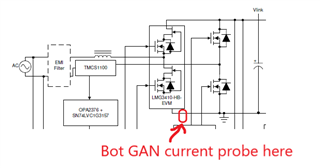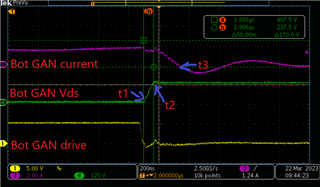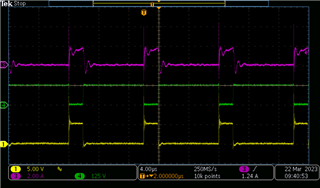Other Parts Discussed in Thread: TIDA-010062,
Hi,
We are developing totem pole bridgeless PFC which based on TIDA-010062. The GAN just use LMG3410R070 demo board LMG3410-HBEVM for high frequency switch. In our test, we found that PFC efficiency is not high. The main loss may be GAN. We use DC input and set PWM duty cycle of fixed 0.2 or 0.5. When Vbus voltage raised to high voltage, the bot GAN temperature become higher than top GAN. Our analysis is Bot GAN switch off power loss is high. Below is waveform of Bot GAN, please help to check.



The waveform is BOT GAN driver, Vds and current with Zoom In.
Input is 100V DC and output VBUS is 125V with 1A load. Duty is fixed of 0.2.
From t1, GAN switch off, current drive Coss so that Vds increased to 125V.
Question 1: The rise time of Vds is about 68ns, which seem too slow. According 2A current to drive Coss of about 150pf to 125V. The time should be C*U/I= 9.4ns. Why here is 68ns?
Question 2: From t2 to t3 of about 200ns, although Vds is 125v and GAN switch off, but there still have current draw from D to S. The deadtime is 100ns. So 32ns after t2, top Gan already swithed on. But current still pass through Bot GAN, which act like reverse recovery but in fact GAN should no this feature. This U*I involve much higher power loss. Do you know what happened at t2 to t3?
From below waveform of Top GAN, we can see current is not flow to TOP GAN immediately after Bot GAN switching off. From t4 to t5, TOP GAN in the Third Quadrant operation. But current maily not through TOP GAN. After t5, TOP GAN was completely switched on, but current still raised slowly till t6 then all current though TOP GAN. The Delta of current from t5 to t6 is current through BOT GAN of t2 to t3.

Please help to check the waveforms, thanks.


